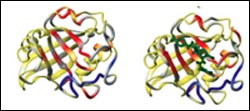The dynamic personalities of proteins reveal key traits

A new window opens on structure and function of enzymes
A Brandeis University study published in Nature this week advances fundamental understanding of the dynamic personalities of proteins and proposes that these enzymes are much more mobile, or plastic, than previously thought. The research, based on nuclear magnetic resonance (NMR) experiments, may shed new light on how to improve rational drug design through docking to dynamic targets.
For the first time ever, the study linked both the low-energy as well as the much rarer high-energy state of enzymes to their function, said lead author Brandeis biophysicist Dorothee Kern, who is also an investigator at the Howard Hughes Medical Institute.
This is important because drugs seek to bind, or dock, to target enzymes in the infrequent high-energy state. Kern believes the study brings scientists a step closer to a new area of research that seeks to elucidate the structures of enzymes in high-energy states that can be ultimately used for rational drug design.
“This research shifts the paradigm of how we thought proteins work. The traditional view is that proteins are not terribly dynamic when they do not perform their function, and that they become dynamic only during catalysis, their active state. What we have learned now is that there is no resting state, that even in the absence of substrates, before catalysis, defined motions of many atoms is an intrinsic property of these enzymes,” explained Kern.
“Much like a rousing basketball game – in which all the players continuously but strategically move with or without the ball – nature has evolved these biomolecules so that they are constantly moving in highly-defined directions conducive to their function with or without the substrate,” explained Kern, who played for the East German National basketball team before the Berlin Wall fell in 1989 and later professional basketball for united Germany.
The research involved NMR studies of the enzyme cyclophilin A, a highly conserved protein found in all organisms from yeast to the human body, and which is involved in HIV replication in humans. Elucidating the role that cyclophilin A plays in the body would be a major step toward creating drugs that impede its virulence, without interfering with normal cellular function.
Kern summed up: “The fundamental principal of life is that molecules constantly change over time –that is the definition of dynamics.”
Media Contact
More Information:
http://www.brandeis.eduAll latest news from the category: Life Sciences and Chemistry
Articles and reports from the Life Sciences and chemistry area deal with applied and basic research into modern biology, chemistry and human medicine.
Valuable information can be found on a range of life sciences fields including bacteriology, biochemistry, bionics, bioinformatics, biophysics, biotechnology, genetics, geobotany, human biology, marine biology, microbiology, molecular biology, cellular biology, zoology, bioinorganic chemistry, microchemistry and environmental chemistry.
Newest articles

Properties of new materials for microchips
… can now be measured well. Reseachers of Delft University of Technology demonstrated measuring performance properties of ultrathin silicon membranes. Making ever smaller and more powerful chips requires new ultrathin…

Floating solar’s potential
… to support sustainable development by addressing climate, water, and energy goals holistically. A new study published this week in Nature Energy raises the potential for floating solar photovoltaics (FPV)…

Skyrmions move at record speeds
… a step towards the computing of the future. An international research team led by scientists from the CNRS1 has discovered that the magnetic nanobubbles2 known as skyrmions can be…





















